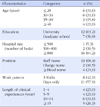Abstract
Purpose
This study was conducted to explore clinical nurses' experience of positive organizational culture in order to provide data for effective strategies of acquisition and retention of competent nurses.
Methods
In this qualitative study, interviews with four focus groups of four to six nurses, 19 in total, were held. Compositional factors in groups included clinical experience, age, work place, and position. Interviews proceeded until data were saturated.
Results
Fifteen sub-themes, categorized into six themes, emerged. Positive organizational culture themes included "Helping nurses to be organization members", "Allowing nurses to communicate with one another", "Helping nurses take an initiative to lead organization", "Having competent leader take charge of organization", "Enabling nurses to achieve organizational changes", and "Leading nurses to accomplish organizational performance."
Conclusion
Results indicate that positive organizational culture is related to increases in occupational satisfaction and decreases in turnover through supportive organizational culture which makes it possible to reinvest expenses required for training new members to promoting quality growth in the organization and the prestige of professional nurses. In order to improve occupational satisfaction and sustained growth in nurses, it is necessary to provide nurses with positive work environments and require members to make active efforts leading to strategic changes.
Figures and Tables
References
1. Korean Hospital Nurses Association. Status of hospital nurse staffing on 2009. Seoul: Korean Hospital Nurses Association;2009.
2. Aiken LH, Clarke SP, Sloane DM, Sochalski J, Silber JH. Hospital nursestaffing and patient mortality, nurse burnout, and job dissatisfaction. JAMA. 2002; 288(16):1987–1993. http://dx.doi.org/10.1001/jama.288.16.1987.
3. Buerhause PI, Donelan K, Ulrich BT, Norman L, DesRoches C, Dittus R. Impact of the nurse shortage on hospital patient care: Comparative perspectives. Health Aff (Millwood). 2007; 26(3):853–862. http://dx.doi.org/10.1377/hlthaff.26.3.853.
4. Cooke RA, Rousseau DM. Behavioral Norms and Expectations: A quantitative approach to the assessment of organizational culture. Group Organ Manag. 1988; 13(3):245–273. http://dx.doi.org/10.1177/105960118801300302.
5. Van Ess Coeling H, Wilcox JR. Understanding organizational culture: A key to management decision-making. J Nurs Adm. 1988; 18(11):16–23.
6. Appelbaum SH, Zinati SM, MacDonald A, Amiri Y. Organizational transformation to a patient centric culture: A case study. Leadersh Health Serv. 2010; 23(1):8–32. http://dx.doi.org/10.1108/17511871011013742.
7. Han SJ. A study on the relationship between nursing organizational culture and organizational performance. J Korean Acad Nurs Adm. 2002; 8(3):441–456.
8. An JY, Yom YH, Ruggiero JS. Organizational culture, quality of work life, and organizational effectiveness in Korean nurses. J Transcult Nurs. 2011; 22(1):22–30. http://dx.doi.org/10.1177/1043659609360849.
9. Choi J, Ha NS, Park HM. The Relationship between 7S factors of the nursing organizational culture and organizational effectiveness. J Korean Acad Nurs Adm. 2004; 10(2):255–264.
10. Yu GW, Min S, Ha YJ, Na SS, Kim HS. The influence of nurses' perceived organizational culture type on organization efficiency at the public health center. Daehan J Bus. 2009; 22(1):525–550.
11. Kwon HJ, Suk BH, Chee SJ, Ahn YM, Kim YJ, Park SA, et al. The relationships between the types of nursing organizational culture, nurses' satisfaction with life, and job satisfaction. J Korean Clin Nurs Res. 2011; 17(1):57–69.
12. Im SB, Kim SY, Ko Y, Lee MY. Clinical nurses' perceptions on nursing organizational culture and differences in their perceptions according to age groups. J Korean Clin Nurs Res. 2012; 18(2):215–227.
13. Lee HS, Kim JK. Relationship among communication competence, communication types, and organizational commitment in hospital nurses. J Korean Acad Nurs Adm. 2010; 16(4):488–496.
14. Bellot J. Nursing home culture change: What does it mean to nurses? Res Gerontol Nurs. 2012; 5(4):264–273. http://dx.doi.org/10.3928/19404921-20120906-02.
15. Malloy DC, Hadjistavropoulos T, McCarthy EF, Evans RJ, Zakus DH, Park IY, et al. Culture and organizational climate: Nurses's insights into their relationship with physicians. Nurs Ethics. 2009; 16(6):719–733. http://dx.doi.org/10.1177/0969733009342636.
16. Kwon SB. A study on nursing organizational culture in hospital setting [dissertation]. Seoul: Chungang University;2000.
17. Jung OB. Organizational culture experienced by clinical nurses [dissertation]. Taegu: Kyungpook National University;2011.
18. Kim SJ, Kim HJ, Lee KJ, Lee SW. Research methodology for focus group. Seoul: Hyunmoonsa;1999.
19. Brink PJ, Wood MJ. Advanced design in nursing research. Thousand Oaks, CA: Sage Publications;1989.
20. Morgan DL. Korean Association for Qualitative Research. Focus groups as qualitative research. 2nd ed. Seoul: Koonja;2007.
21. Kim KJ, Han JS, Seo MS, Jang BH, Park MM, Ham HM, et al. Relationship between intra-organizational communication satisfaction and safety attitude of nurses. J Korean Acad Nurs Adm. 2012; 18(2):213–221. http://dx.doi.org/10.11111/jkana.2012.18.2.213.
22. Kang KH, Ko YK. Change commitment and learning orientation as factors affecting the innovativeness of clinical nurses. J Korean Acad Nurs Adm. 2013; 19(3):404–413. http://dx.doi.org/10.11111/jkana.2013.19.3.404.
23. Im SI, Park J, Kim HS. The effects of nurse’s communication and self-leadership on nursing performance. Korean J Occup Health Nurs. 2012; 21(3):274–282. http://dx.doi.org/10.5807/kjohn.2012.21.3.274.
24. Kim MJ, Koh MS. Mediating effects of self-leadership on the relationship between nurses' core self-evaluation and innovative behaviour. Health Soc Sci. 2011; 30:171–198.
25. McClure ML. American Academy of Nursing, Task Force on Nursing Practice in Hospitals. Magnet hospitals: Attraction and retention of professional nurses. Kansas City, Mo.: American Nurses' Association;1983.
26. Kang KN. Factors influencing turnover intention of nurses in small-medium sized hospitals. J Korean Acad Nurs Adm. 2012; 18(2):155–165. http://dx.doi.org/10.11111/jkana.2012.18.2.155.
27. Kim SY, Kim EK, Lim HM, Lee MY, Park KO, Lee KA. Structural equation modeling on nursing productivity of nurses in Korea. J Korean Acad Nurs. 2013; 43(1):20–29. http://dx.doi.org/10.4040/jkan.2013.43.1.20.




 PDF
PDF ePub
ePub Citation
Citation Print
Print





 XML Download
XML Download